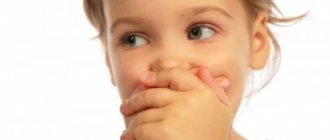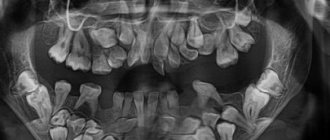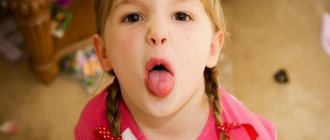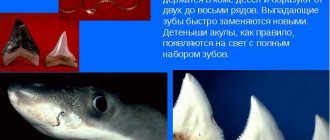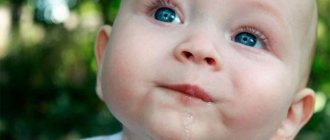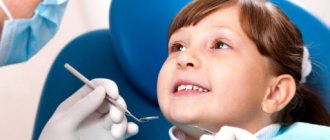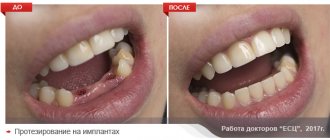Anatomy of permanent teeth
Each molar consists of certain parts:
- crown. This is the part of the tooth that protrudes from the top;
- the root, it goes deep into the alveoli. At the same time, it is attached thanks to special connective tissue bundles. There can be different numbers of roots (1-5 pieces). This moment affects the number of nerves and channels;
- neck. This part is located between the root and the crown.
Tooth tissues are distinguished by their heterogeneity. The enamel is on top and is known for its durability. Once the tooth has erupted, it is covered with a transparent thin layer. This is the cuticle, which eventually changes to the pellicle. The latter is a film that is created from what saliva produces.
Beneath the enamel is dentin, the tissue of the tooth. Dentin is similar to bone when you study how it is built. However, it is more durable because there is a high level of mineralization. In the area where the root is located, the dental tissue is covered with cement. The latter is rich in mineral compounds and is also associated with periodontium. Collagen fibers are used for this.
As for the part of the tooth that is inside, this is the crown and root canal. They are filled with pulp. This is loose connective tissue; it contains nerve endings and blood vessels.
Differences between baby teeth and permanent teeth
Permanent and temporary teeth are built in the same way, but still have certain differences between themselves:
- The enamel on baby teeth is whiter. And the enamel on permanent teeth has a yellowish tint;
- the best indicators of density and mineralization are noted behind the molars;
- the pulp of a baby tooth is large in size, and the dense tissues and their walls are thinner;
- permanent teeth are larger in size, here the length is greater than the width;
- The root of baby teeth is short and thin compared to permanent teeth. When the root of temporary teeth is formed, they expand in width. Therefore, the permanent bud has free space to grow.
Possible dental problems
Parents of mature toddlers, in addition to the number of teeth at three years old, are also concerned about other dental problems. They are identified independently at home, at the next appointment with the dentist. List common deviations from standards.
The child has dark tooth enamel, yellowish molars
The cause of discoloration is poor cleaning, ignoring the rules of oral hygiene, taking iron-containing medications, and diseases of the internal organs.
Carious spots on teeth
Most adults are greatly mistaken if they believe that baby teeth do not need to be treated for caries. Pathogenic bacteria infect dental tissue, settle in the oral cavity for a long time, and subsequently destroy molars. The tooth begins to turn black from the central part, sometimes large black spots of different sizes appear on the enamel.
To avoid caries on baby teeth, you need to accustom your baby to daily hygiene and consume sufficient amounts of vitamins and minerals in food.
Periodontitis
When the tissue around the tooth becomes inflamed or the integrity of the cortical plate is compromised, the child’s gums become swollen, the cheeks increase in size, and the baby experiences constant aching pain. The cause of the disease is advanced caries and fungal infections.
At the age of 8-10 years, dentists are forced to remove a molar tooth for children with periodontitis, since the tissue changes are already irreversible.
It is important to pay attention to this problem during the period when it is possible to treat inflamed elements of the jaw.
Pulpitis
The nutrition of the hard tissues of the incisors is disrupted. The pulp is located inside the dental canal and consists of a nerve, a vessel, and connective cells. Destruction of the structure of this part of the molar leads to tissue starvation, death, and the incisors will crumble. Pulpitis affects not only the erupted tooth, but its rudiments.
Hypoplasia of tooth enamel
Molars become thinner, easily ground down and worn out. The pathology is genetic in nature and develops in utero.
Malocclusion
The teeth of the opposite rows do not close together due to prolonged sucking of a pacifier, heredity, bad habits: holding a finger in the mouth, gnawing on toys, etc.
Where do teeth come from?
Teeth begin to form and develop when the fetus is still inside the womb (at about 6 weeks). They have their source - the epithelial dental plate. Already by 14 weeks, active formation of dental tissues, which are hard, occurs. Initially, this occurs in the area where the crown will be, and later at the root.
Molars, namely their first rudiments, appear by the 5th month of the embryo. They are located higher than the child’s baby teeth or lower. By the time the child is born, the rudiments are already practically formed in the tissues of the jaw.
Teeth that belong to an additional group (have no predecessors) are formed later. This occurs after about 1 year of life. Why? Because the baby's jaw is still very small and there is not enough space for them.
Symptoms of teething in children
Signs of teething in infants can be observed already 3-5 days before teething. Symptoms continue until the crowns of the teeth appear through the mucous membrane of the gums. The main symptoms of teething in infants are:
- redness and swelling of the gums at the site of eruption,
- irritability,
- bad dream,
- poor appetite, refusal to eat,
- the child tries to bite whatever he can, trying to relieve the itching in the gums,
- increased salivation and drooling,
- rash and irritation in the mouth and chin area, as well as on the chest (occur due to drooling from the mouth).
→ Homeopathic remedies for teething → Pain-relieving gels for topical use
Additional signs of teething in children:
- How long does the temperature last during teething in children? For most children, teething does not lead to an increase in temperature.
High temperature is usually a consequence of some concomitant inflammatory process unrelated to teething. For example, it may increase against the background of ARVI, or against the background of herpetic stomatitis of the oral cavity (the latter is characterized by the symptoms described below). It is worth carefully examining the mucous membrane of the child’s oral cavity for the presence of - 1) small blisters filled with clear or cloudy liquid, 2) small erosions surrounded by inflamed bright red mucous membrane, 3) bright red inflamed gums. In a 1-year-old child, antibodies to the herpes virus received from the mother during pregnancy gradually disappear, and trauma to the mucous membrane from teething is a trigger for the development of viral stomatitis. - Hematomas on the mucous membrane of the gums (Fig. 8) - in some children, 2-3 weeks before teething, a lump filled with clear or bluish liquid may appear on the gum. This does not indicate inflammation or any pathology, and usually does not require intervention (only if this formation has reached too large a size, a small incision is made to release the bloody fluid).
- Coughing and vomiting during teething – increased salivation is observed during teething, and if the child has swallowed saliva, then such symptoms may be present. If vomiting occurs against the background of a high temperature or abnormal stool (diarrhea), then teething has nothing to do with it. In this case, you should immediately suspect rotavirus and urgently call a pediatrician home.
Important : we repeat once again that high fever, vomiting and diarrhea cannot in any way be associated with teething. Their causes are intoxication of the body against the background of a concomitant infectious process (influenza, ARVI), rotavirus infection. In these cases, you should definitely call a pediatrician.
If you find herpetic rashes (vesicles, erosions) on the mucous membrane of the child’s mouth, or all the gums are bright red, then this is typical for herpetic gingivostomatitis. In this case, it is better to call a pediatric dentist from a pediatric dental clinic at your place of residence, because Pediatricians in most cases do not know that there are several forms of stomatitis, each of which is treated differently.
What does a dental formula look like?
To make it more convenient to describe teeth and their number, special formulas are usually used. Each tooth has its own number, which is used to decipher its location.
When describing a milk bite, Roman numerals are used:
- incisors – I, II;
- canine – III;
- molars – IV, V.
If we talk about the formula for adult teeth, here the teeth are counted starting from the center:
- incisors – 1.2;
- fang – 3;
- molars (small) – 4.5;
- molars (large) – 6,7,8.
8 is a wisdom tooth; not every person has it.
Teething order
Typically, all children start teething at about the same time. Teeth emerge from the molar set at the age of 5, and it is the molars (large ones) that emerge. Then the diagram is as follows:
- Initially, the incisors on the lower jaw change, which are located in the center;
- then the central incisors appear on the upper jaw and the incisors on the sides on the lower jaw;
- at about 8-9 years old, the incisors on the top and sides change;
- up to 12 years of age, molars (small) grow;
- at the age of 13, the fangs change;
- after the child turns 14 years old, the second molars (large ones) come in. They were not included in the milk kit;
- and after another 1 year the third molars (large) appear. This is a wisdom tooth. But he may not appear at all.
Caring for baby teeth
Children should be taught oral care procedures from early childhood. After the first teeth appear, it is recommended to gently wipe them once a day with a clean piece of gauze soaked in boiled water. As your baby gets older, you can purchase your own soft-bristled brush and brush your teeth with water. After the baby reaches one year of age, it is recommended to purchase a special paste and teach him how to care for the oral cavity on his own.
Teeth of the upper and lower jaw
Milk teeth, like permanent teeth, are susceptible to decay and caries, which can appear even in children under two years of age.
On a note! The main feature of childhood caries is multiplicity, that is, it often affects not one, but several teeth, penetrating into the deep layers of tissue.
At the spot stage, the disease is treated with fluoridation; in case of an extensive pathological process, cleaning of carious cavities and removal of infected tissues is necessary.
Formula for recording baby teeth using the Haderup system
How to determine that a child will soon have molars?
There are certain signs that indicate that permanent teeth will soon begin to erupt:
- The spaces between the teeth increase. The jaw grows and the free space increases;
- baby teeth become loose as the root gradually dissolves. It cannot be firmly fixed in the jaw tissues;
- in case of loss of a temporary tooth. This confirms that the molar will soon come out as it has pushed out the previous one;
- The gums are slightly swollen and red.
When permanent teeth erupt, the child’s general well-being usually remains the same, the temperature does not rise, and there is no pain.
What are baby teeth?
Milk teeth are the teeth that are the first to erupt in humans. Their rudiments are formed in the womb, at approximately 5-7 weeks of pregnancy, and by the age of three the child already has 20 teeth. Milk teeth differ from permanent teeth in structure (they are smaller and have a different shape), and the bite does not contain small molars, or premolars.
X-ray of baby teeth
Possible problems
Permanent teeth have just appeared, but this does not mean that there will not immediately be any problems associated with them. Parents should be aware of possible dental problems:
- lack of molars;
- pain in the molar area;
- crooked position of molars;
- molars fall out;
- injuries.
For any of these problems, it is important to contact a specialist in time to receive qualified help.
